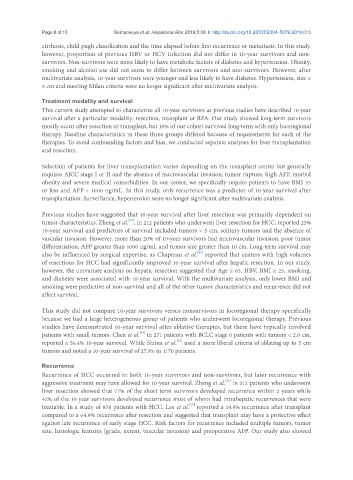Page 392 - Read Online
P. 392
Page 8 of 10 Sempokuya et al. Hepatoma Res 2019;5:38 I http://dx.doi.org/10.20517/2394-5079.2019.013
cirrhosis, child pugh classification and the time elapsed before first recurrence or metastasis. In this study,
however, proportion of previous HBV or HCV infection did not differ in 10-year survivors and non-
survivors. Non-survivors were more likely to have metabolic factors of diabetes and hypertension. Obesity,
smoking and alcohol use did not seem to differ between survivors and non-survivors. However, after
multivariate analysis, 10-year survivors were younger and less likely to have diabetes. Hypertension, size ≥
5 cm and meeting Milan criteria were no longer significant after multivariate analysis.
Treatment modality and survival
This current study attempted to characterize all 10-year survivors as previous studies have described 10-year
survival after a particular modality: resection, transplant or RFA. Our study showed long-term survivors
mostly occur after resection or transplant, but 10% of our cohort survived long-term with only locoregional
therapy. Baseline characteristics in these three groups differed because of requirements for each of the
therapies. To avoid confounding factors and bias, we conducted separate analyses for liver transplantation
and resection.
Selection of patients for liver transplantation varies depending on the transplant center but generally
requires AJCC stage I or II and the absence of macrovascular invasion, tumor rupture, high AFP, morbid
obesity and severe medical comorbidities. In our center, we specifically require patients to have BMI 35
or less and AFP < 1000 ng/mL. In this study, only recurrence was a predictor of 10-year survival after
transplantation. Surveillance, hypertension were no longer significant after multivariate analysis.
Previous studies have suggested that 10-year survival after liver resection was primarily dependent on
[22]
tumor characteristics. Zheng et al. , in 212 patients who underwent liver resection for HCC, reported 23%
10-year survival and predictors of survival included tumors < 5 cm, solitary tumors and the absence of
vascular invasion. However, more than 20% of 10-year survivors had microvascular invasion, poor tumor
differentiation, AFP greater than 1000 ng/mL and tumor size greater than 10 cm. Long-term survival may
[23]
also be influenced by surgical expertise, as Chapman et al. reported that centers with high volumes
of resections for HCC had significantly improved 10-year survival after hepatic resection. In our study,
however, the univariate analysis on hepatic resection suggested that Age ≥ 65, HBV, BMI ≥ 25, smoking,
and diabetes were associated with 10-year survival. With the multivariate analysis, only lower BMI and
smoking were predictive of non-survival and all of the other tumor characteristics and recurrence did not
affect survival.
This study did not compare 10-year survivors versus nonsurvivors in locoregional therapy specifically
because we had a large heterogeneous group of patients who underwent locoregional therapy. Previous
studies have demonstrated 10-year survival after ablative therapies, but these have typically involved
[14]
patients with small tumors. Chen et al. in 271 patients with BCLC stage 0 patients with tumors < 2.0 cm,
[24]
reported a 56.4% 10-year survival. While Shiina et al. used a more liberal criteria of ablating up to 5 cm
tumors and noted a 10-year survival of 27.3% in 1170 patients.
Recurrence
Recurrence of HCC occurred in both 10-year survivors and non-survivors, but later recurrence with
[22]
aggressive treatment may have allowed for 10-year survival. Zheng et al. in 212 patients who underwent
liver resection showed that 77% of the short term survivors developed recurrence within 2 years while
42% of the 10 year survivors developed recurrence most of whom had intrahepatic recurrences that were
[25]
treatable. In a study of 878 patients with HCC, Lee et al. reported a 19.8% recurrence after transplant
compared to a 64.9% recurrence after resection and suggested that transplant may have a protective effect
against late recurrence of early stage HCC. Risk factors for recurrence included multiple tumors, tumor
size, histologic features (grade, extent, vascular invasion) and preoperative AFP. Our study also showed

